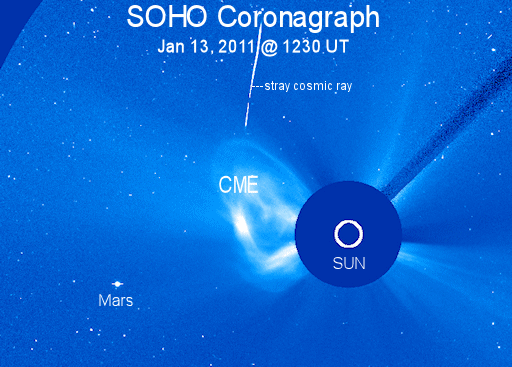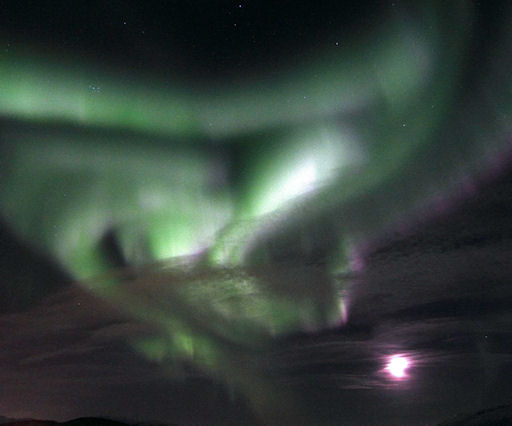Metallic photos of the sun by renowned photographer Greg Piepol bring together the best of art and science. Buy one or a whole set. They make a stellar gift. | | | SUNDIVING COMET STORM: 2010 ended with an unprecedented flurry of small comets diving into the Sun. Researchers say this could herald a much larger comet still to come. Get the full story from Science@NASA. FARSIDE ERUPTION: An active region on the far side of the sun erupted this morning, hurling a bright CME into space. The Solar and Heliospheric Observatory (SOHO) saw the cloud emerging over the sun's eastern limb: 
Update: Click here to make the cloud expand
NASA's STEREO-B spacecraft happens to be stationed almost directly over the blast site. The spacecraft's extreme UV telescope caught the explosion from the beginning; this movie shows the eruption and the shadowy shock wave it propelled through the sun's atmosphere. The source of this activity, probably a big sunspot, is on the farside of the sun now, but won't remain there. The sun's rotation is turning it toward Earth. Geoeffective solar activity could commence within days. Stay tuned. AURORA WATCH: This week, auroras around the Arctic Circle have been so bright, even clouds and glaring moonlight could not spoil the show. Frank Olsen sends this picture, taken on Jan. 12th, from Skittenelv, Norway: 
"The past few days have brought us some great auroras," says Olsen. "The lights were so bright, I was able to record them with shutter speeds as low as 1 second using my Canon EOS 7D set at ISO 1600." Polar photographers should take note of those settings. Another display is likely on Jan. 14-15 when an incoming solar wind stream hits Earth's magnetic field, and a great snapshot may be only 1 second away. January 2011 Aurora Photo Gallery
[previous Januaries: 2010, 2009, 2008, 2007, 2005, 2004]
Solar Eclipse Photo Gallery
[NASA: Hinode Observes Annular Solar Eclipse] Potentially Hazardous Asteroids ( PHAs) are space rocks larger than approximately 100m that can come closer to Earth than 0.05 AU. None of the known PHAs is on a collision course with our planet, although astronomers are finding new ones all the time. On January 13, 2011 there were 1179 potentially hazardous asteroids. Notes: LD means "Lunar Distance." 1 LD = 384,401 km, the distance between Earth and the Moon. 1 LD also equals 0.00256 AU. MAG is the visual magnitude of the asteroid on the date of closest approach. | | The official U.S. government space weather bureau | | | The first place to look for information about sundogs, pillars, rainbows and related phenomena. | | | Researchers call it a "Hubble for the sun." SDO is the most advanced solar observatory ever. | | | 3D views of the sun from NASA's Solar and Terrestrial Relations Observatory | | | Realtime and archival images of the Sun from SOHO. | | | from the NOAA Space Environment Center | | | the underlying science of space weather | | 
